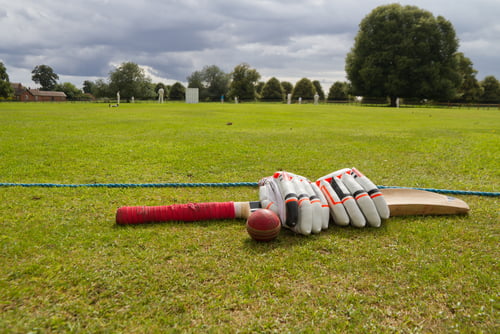Equipment required for Cricket

Image credit: Shutterstock.com
All equipment that players require in a game of cricket are strictly regulated by the Laws of Cricket, a set of rules that apply to cricket games across the world.
Ball
The ball used in cricket is a cork ball covered in leather. Cricket balls are very hard and can cause injuries upon impact with the body, weighing between 155.9 grams to 163 grams. The two most common colours of cricket balls are red – used in Test cricket and First Class cricket, and white - used in One-day matches.
Bat
Bats used in cricket are made of flat wood, and connected to a conical handle. They are not allowed to be longer than 96.5 centimeters and have to be less than 10.8 centimeters wide. While there is no standard weight, most bats range between 1.2 kilograms to 1.4 kilograms.
Clothing
Cricket players are required to don a polo t-shirt in every match. Depending on the weather, long sleeved polo t-shirts are also sometimes worn, as well as woollen jumper or vest. Additionally, players traditionally wear white long trousers.
Headwear such as baseball caps, sun hats as well as cricket caps are also allowed. Additionally, players wear spiked shoes, in order to improve traction on the playing area.
Protective Equipment
Like many other sports, cricket players are required to wear protective gear in order to ensure their safety during the match. Batsmen and wicket keepers usually wear an abdomen guard, also known as a cup, box or abdo guard, in order to protect themselves against the impact of the ball hitting the body. Leg pads are also worn by batsmen and wicket keepers in order to protect the shins, and fielders tationed near the batsmen might also choose to use leg pads.
Additionally, a helmet (sometimes with a visor attached) is worn by batsmen and fielders in order to protect their heads from the incoming ball. Wicket keepers also wear protective eyewear to protect their eyes, as the impact of the ball hitting the wicket can be great, and bails might get dislodged after impact.
Batsmen wear special gloves that are different from gloves worn by wicket keepers. These are very thickly padded at the top of all five fingers, compared to the thinner wicket keeper gloves. The wicket keeper gloves sometimes also feature webbed fingers, in order to help the wicket keepers catch the ball.
Video credit: Sikana
To receive the latest updates on the happenings in the Singapore sports scene, or to find out more about some of the latest programmes on offer at ActiveSG, like our Facebook page here.




![ActiveSG Academies and Clubs Logo (Solid Colour)[8647]](https://www.activesgcircle.gov.sg/hs-fs/hubfs/ActiveSG%20Circle%202023Theme/images/ActiveSG%20Academies%20and%20Clubs%20Logo%20(Solid%20Colour)%5B8647%5D.png?width=150&height=65&name=ActiveSG%20Academies%20and%20Clubs%20Logo%20(Solid%20Colour)%5B8647%5D.png)



-01.png?width=200&height=141&name=Team%20Singapore%20Logo%20(Red)-01.png)



